

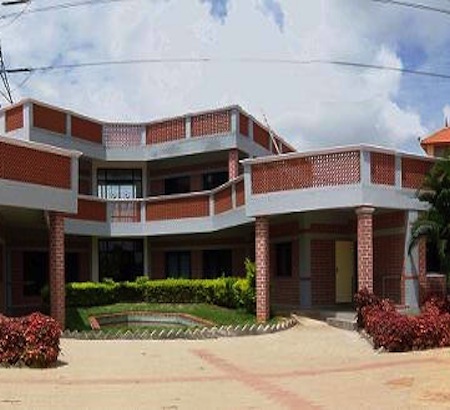
Scalene Energy Water Corporation limited is the commercial wing of Scalene Energy Research Institute (SERI). Scalene established SERI in 2002 with the aim of bringing about Energy Self Sufficiency and Sustainable Growth. Many years of research has finally culminated into SERIGAS and FPSTAR Technology one of the most efficient biomethanization process and water recovery system.
SERI developed the MIBR reactor technology, CO2 rebreather, specialised refinery for gas purification, proprietary technology for storage of natural gas, (Thermomegasonic deagglomeration reactor) TMDR to produce crude oil from plastic, HYDRODECIDER to produce cooking gas from Sunlight and Vegetable oil, and several other innovations. To commercialise technologies developed by SERI, the Scalene Energy Water Corporation Limited was established in 2010. SEWCL has already constructed many Large, Mini Organic Natural Gas and Power plant for many customers in different parts of the world.
Scalene Energy – Water Corporation Limited (SE-WCL) provides total turnkey solutions for Waste to Energy and Water Recovery including feasibility study, sizing, design, supply of equipment, installation/erection, testing, training, operation and maintenance, proactively reducing the carbon footprint while harnessing the immense potential of abundantly available bio resources in an eco-friendly and economical method.
About 70% of the earth’s surface is covered with water. Ninety-seven percent of the water on the earth is salt water. Salt water is saturated with salt and other minerals, and humans cannot drink this water. Although the salt can be removed, it is a difficult and expensive process.
Two percent of the water on earth is glacier ice at the North and South Poles. This ice is fresh water and could be melted; however, it is too far away from where people live to be usable.
Less than 1% of all the water on earth is fresh water that we can actually use. We use this small amount of water for drinking, transportation, heating and cooling, industry, and many other purposes.

In India, industry is the second highest consumer of water. It is estimated that the current industrial water use in India is about 13 per cent of the total freshwater withdrawal in the country and the water demand for industrial uses and energy production will grow at a rate of 4.2 per cent per year, rising from 106 billion cubic metres in 2013 to 228 billion cubic metres by 2025. All these estimates reveal that the industrial water demand is not negligible in India and that it is bound to grow in the coming years. Industries not just consume water but also pollute it. According to the World Development Report (WDR) of 2003, in developing countries, 70 per cent of industrial wastes are dumped without treatment, thereby polluting the usable water supply. Note that industrial water demand is not the demand for water as in other sectors, as a large part of the water withdrawn for industrial use is discharged as polluted water by the industries. According to CSE (2004), on an average, each litre of wastewater discharged further pollutes about 5–8 litres of water which raises the share of industrial water use to somewhere between 35–50 per cent of the total water used in the country, and not the 7–8 per cent that is considered as the industrial water use. Polluted water is very rarely used by industries.
The waste water treatment system by most of the industries are essentially installed to meet the wastewater discharge norms, which are concentration based, that is, they measure the concentration of pollution in a given quantity of water. The result is that an industry can meet the required standard merely by diluting the waste water with clean water. Since the cost of water is low, it makes more economic sense for an industry to dilute the effluent than to treat it to meet the standards.
Water once used is generally thrown without any further use, even if it can be reused. Segregation of wastewater from various processes into clean water (that can be reused), and contaminated water, is not commonly done. The result is that even the uncontaminated water gets contaminated after mixing and is discharged as effluent.
India today consumes 693 billion cubic metre (1 Cubic Metre = 1000 litres) of water annually, this is going to increase to 942 billion cubic metre by 2025 and 1,422 billion cubic metre by 2050. Have we ever thought how we are going to meet this demand ?
On the other side, India discharges 48,797 million cubic metres of waste water annually, enough and more for the needs of our entire population. Shouldn’t we have a technology to recover and use this water for sustainable existence ?
About 70% of the earth’s surface is covered with water. Ninety-seven percent of the water on the earth is salt water. Salt water is saturated with salt and other minerals, and humans cannot drink this water. Although the salt can be removed, it is a difficult and expensive process.
Two percent of the water on earth is glacier ice at the North and South Poles. This ice is fresh water and could be melted; however, it is too far away from where people live to be usable.
Less than 1% of all the water on earth is fresh water that we can actually use. We use this small amount of water for drinking, transportation, heating and cooling, industry, and many other purposes.

In India, industry is the second highest consumer of water. It is estimated that the current industrial water use in India is about 13 per cent of the total freshwater withdrawal in the country and the water demand for industrial uses and energy production will grow at a rate of 4.2 per cent per year, rising from 106 billion cubic metres in 2013 to 228 billion cubic metres by 2025. All these estimates reveal that the industrial water demand is not negligible in India and that it is bound to grow in the coming years. Industries not just consume water but also pollute it. According to the World Development Report (WDR) of 2003, in developing countries, 70 per cent of industrial wastes are dumped without treatment, thereby polluting the usable water supply. Note that industrial water demand is not the demand for water as in other sectors, as a large part of the water withdrawn for industrial use is discharged as polluted water by the industries. According to CSE (2004), on an average, each litre of wastewater discharged further pollutes about 5–8 litres of water which raises the share of industrial water use to somewhere between 35–50 per cent of the total water used in the country, and not the 7–8 per cent that is considered as the industrial water use. Polluted water is very rarely used by industries.
The waste water treatment system by most of the industries are essentially installed to meet the wastewater discharge norms, which are concentration based, that is, they measure the concentration of pollution in a given quantity of water. The result is that an industry can meet the required standard merely by diluting the waste water with clean water. Since the cost of water is low, it makes more economic sense for an industry to dilute the effluent than to treat it to meet the standards.
Water once used is generally thrown without any further use, even if it can be reused. Segregation of wastewater from various processes into clean water (that can be reused), and contaminated water, is not commonly done. The result is that even the uncontaminated water gets contaminated after mixing and is discharged as effluent.
India today consumes 693 billion cubic metre (1 Cubic Metre = 1000 litres) of water annually, this is going to increase to 942 billion cubic metre by 2025 and 1,422 billion cubic metre by 2050. Have we ever thought how we are going to meet this demand ?
On the other side, India discharges 48,797 million cubic metres of waste water annually, enough and more for the needs of our entire population. Shouldn’t we have a technology to recover and use this water for sustainable existence ?
FPSTAR stands for Fine Particle Shortwave Thrombotic Agglomeration Reactor. It is a disruptive innovation technology in the water treatment sector. It is inspired by nature, a universal solution for waste, yet customizable to your needs. The process mimics blood clotting in the human body. The unwanted particles are engineered to collide and agglomerate in the reactor and then removed by multi-stage filtration defined by end-use requirement.
Particles finer than 0.1 μm (10-7m) in water remain continuously in motion due to electrostatic charge (often negative) which causes them to repel each other. Once their electrostatic charge is striped (neutralized) by the use of a special technique that forms metcomplex ionization, shortwave bombardment and simultaneously causing flow turbulence, the finer particles start to collide and agglomerate (combine together) under the influence of Vander Waals’s forces. These larger and heavier particles are called Thrombus (clots) and the process is called Fine Particle Thrombousthai Reaction and is done in a Fine Particle Thrombousthai Reactor or FPTR.
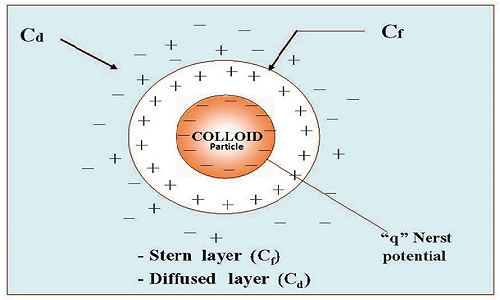
In a typical FPTR reactor, a similar mechanism is mimicked; first the fine particles in liquids behave in the same way as the fibrinogen in the blood, with sticky portion at the center and a negative charge as shown in figure above. The charge here is clipped off by applying high intensity shortwaves through a specialized system of surfaces called Curdiliser. The Inner vessel of the reactor is known as the Reactor Core consists the curdiliser, which are cylindrical structures made up of complex alloys consisting of Aluminum, Magnesium, Zinc, Copper , Manganese, Titanium and sometimes even Platinum, Iridium, silver and Gold, depending on the particle composition and the waste water to be treated. The liquid to be treated will be pulse fed to the Reactor Core, with a suitable pulsating pump. Flow turbulence is caused by a second pump called the Turbuliser. When an appropriate high energy combined with short wave of different frequencies is delivered to these structures, to form soluble monomeric and polymeric hydroxo- complexes. These Metcomplexes formed depends on the type of alloy, which is chosen for a particular characteristic of the particles that needs to be clotted. These Metcomplexes are the ones that stick together, beginning the formation of clots, like the fibrins in the blood. The figure below gives an idea of the mechanism. The Interesting part of this process is, it can also clot materials that do not otherwise form precipitate (cause (a substance) to be deposited in solid form from a solution by physical or chemical reactions) such as sodium and potassium and non-flocculating (not able to form into an aggregated lumpy or fluffy mass by use of chemicals ) or non-coagulating materials like benzene, toluene or similar complex organic compounds can also be thrombolated (a process of achieving extremely fine particle agglomeration by application of high energy shortwave ) and removed. Tough to remove substances like lignin, a macro molecule composed of three monomers namely p-coumaryl alcohol, coniferyl alcohol, and sinapyl alcohol or its derivatives can also be thrombolated and removed by the FPTR Process by retreating it with extra high tension millimeter wave bombardment.

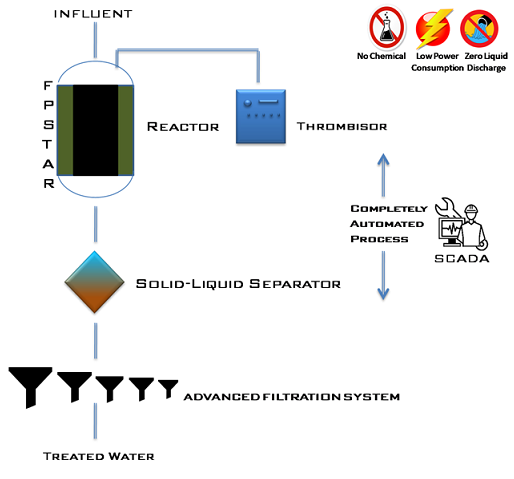
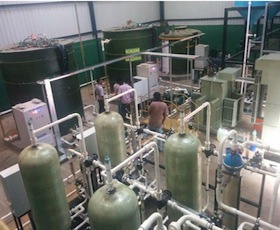
400 KLD-Coffee Effluent-Coorg,Karnataka.
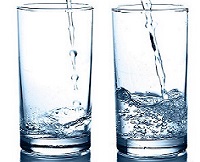 Coffee Pulping Wash Water
Coffee Pulping Wash Water Brewery spent wash
Brewery spent wash Distillery Effluent
Distillery Effluent Sewage water
Sewage water  Lake water
Lake water  Contaminated river water
Contaminated river water  Textile Dying Water
Textile Dying Water  Tannery effluent water
Tannery effluent water  Sea water
Sea water  Automobile Servicing water
Automobile Servicing water Dairy wash water
Dairy wash water  Contaminated ground water
Contaminated ground water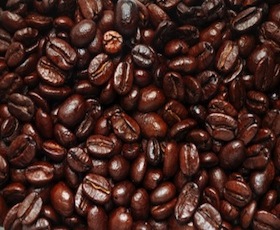
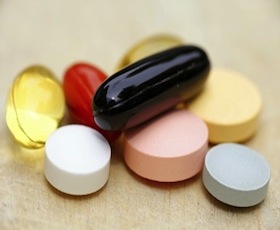
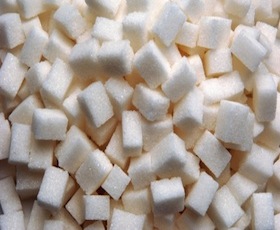
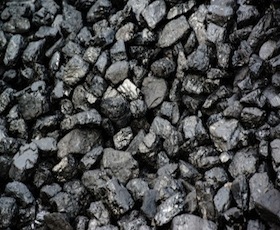
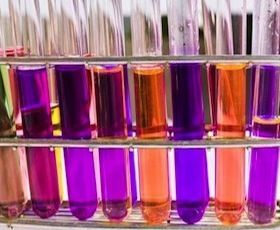




S-CARD CAMPUS,Seegehalli Main Road, Virgo Nagar, Bengaluru,Karnataka-49, India.
Fax Number: +918025614878
Support: info@scaleneaquaria.com
Sales: info@scaleneaquaria.com